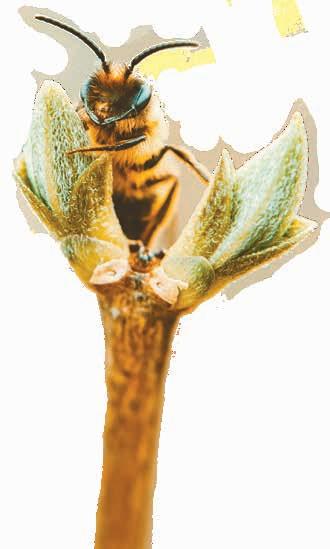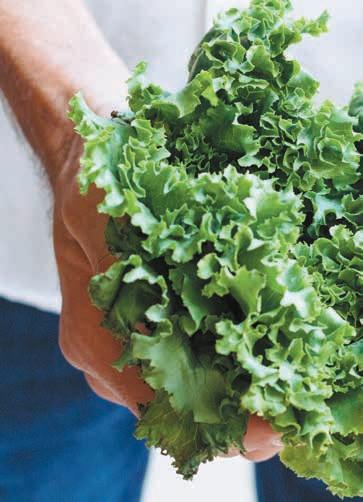
15 minute read
global briefs
from Natural Awakenings Magazine, Palm Beach County Florida March 2021
by Natural Awakenings, Broward and Palm Beach Counties, Florida
global briefs Fishy Business
Saving Coral Reefs Worldwide
The International Coral Reef Initiative (ICRI) has urged governments to take action to save pyvovarova yevheniia/Unsplash.comthe planet’s remaining coral reefs and their attendant fish populations, because collective human impacts are leaving fewer places untouched, with only 15 percent of the Earth’s land mass formally protected and global biodiversity declining at an unprecedented rate. To that end, a new online data platform, MERMAID (DataMermaid.org) helps scientists and management officials collect, organize and disseminate data on reef fish biomass and diversity, as well as the cover of hard corals, fleshy algae and other benthic groups—all identified by ICRI as key indicators of coral reef health, integrity and function.
The newly published 5th Global Biodiversity Outlook and other sources endorsed by the Intergovernmental Panel on Biodiversity and Ecosystem Services clearly indicate that governments are failing to meet existing global targets for biodiversity and that critical ecosystems like coral reefs will be altered to the point that the biodiversity they harbor, and the services they provide, will be irreparably damaged. Currently, only 2.5 percent of the world’s reefs are being actively protected.
Caribbean Offshore Drilling Threatens Florida Beaches
The British-owned Bahamas Petroleum Company (BPC), under a license from the Bahamian government, has begun exploratory oil drilling as deep as 18,000 feet in an area southwest of Andros Island and 150 miles from South Florida. Eighteen members of the U.S. Congress, including the entire South Florida delegation, have warned Bahamian Prime Minister Hubert Minnis of the potential for severe, even catastrophic impact if a spill occurs.
BPC has made assurances that the exploratory well will be sealed and never used again after it completes its exploratory drilling, and supporters of the project say that the process is closely regulated and accidents are rare. Still, Floridians remember the 2010 Deepwater Horizon spill in the Gulf of Mexico that leaked an estimated 164 million gallons of oil and caused billions of dollars in economic and environmental damage. Even a minor accident that leads to a small oil spill could cost the state millions of dollars and disrupt tourism and businesses. Casuarina McKinney-Lambert, executive director of the Bahamas Reef Environment Educational Foundation, says that delicate areas of the Florida Keys would be particularly vulnerable to a spill.
Hot Stuff
The Benefits of Renewable Geothermal Energy
Due to the ongoing decay of radioactive elements in the Earth’s core, temperatures 4,000 miles below the surface can reach 10,800° F. The molten magma we call lava carries enormous heat to the surface. But despite its enormous potential, geothermal energy supplied just 0.4 percent of U.S. electricity in 2019. In California, the perimeter of the inland Salton Sea lies several thousand feet above a mineral-rich cauldron of hot water that powers 10 geothermal plants. The state has emphasized wind and solar power while cardaf/AdobeStock.com neglecting the development of geothermal plants, despite possessing our most productive geothermal fields. The Massachusetts Institute of Technology estimated in 2007 that releasing just 2 percent of this untapped resource in sites around the country could supply 2,000 times our overall primary energy needs without needing any improvements in drilling technology. While the first geothermal plants in the 1960s drained reservoirs of their steam or water, binary plants—a new design from the 1980s—allow operators to extract the heat while maintaining the generating potential. Between 2006 and 2019, the U.S. Department of Energy spent only $1 billion on geothermal technology due to falling coal prices, a fraction of what was spent on fossil fuels and solar investment.

Honey Bees Have a Dirty Secret

Although honey bees symbolize prosperity, sustainability and environmentalism, and are vital to farmers, they also have a distressing effect on the environment—destabilizing natural ecosystems by competing with native bees. Thousands of beekeeping hobbyists and campaigns to save the bees provide honey bees much more media coverage than native pollinators. High densities of honey bee colonies increase competition with the native pollinators for forage, putting even more pressure on the wild species that are already in decline. Honey bees are extremely general foragers and monopolize floral resources, leading to exploitative competition where one species uses up a resource, not leaving enough to go around.
Sheila Colla, an assistant professor and conservation biologist at Toronto’s York University, tells Scientific American, “Beekeeping is for people; it’s not a conservation practice. People mistakenly think keeping honey bees, or helping honey bees, is somehow helping the native bees, which are at risk of extinction. The focus on neonics [pesticide] and honey bees has taken a ton of resources away from conserving wild pollinators from their most important threats.”

Let’s Get You & Your Space Healthy! All services can be done online. 561-367-5010 JEFengShui.com

Nurture your mind with great thoughts. To believe in the heroic makes heroes. ~Benjamin Disraeli
Interactions of Grapefruit & Medications
by Dr. William H. Stager

Grapefruits and grapefruit juice interact with a number of medicines. There is a certain enzyme in the liver and small intestine called “P450, CVP3A4” which metabolizes much of what we eat. It’s one of many enzymes located throughout our digestive system. Grapefruit has a particular chemical in it called “furanocoumarin” which is a natural part of it. This chemical degrades or destroys some of the enzyme so that there’s not enough remaining to do its job of metabolizing what we ingest. It’s the case of one chemical destroying another—all perfectly natural and temporary as our body makes more enzymes to replace the lost ones. Research has discovered two additional biochemicals which may slightly influence grapefruit and certain


Spring is in the Air
From the creators of Smudge in Spray
Good Luck

Fresh & Woody
Miracle Water
Sweet & Floral
Sleep Well
Mellow & Herbaceous The Crystal Garden is Evolving
WE’VE GONE VIRTUAL!
While we’re not accepting guests into our building at this time, we’re still off ering the same great service virtually. Shop our improved website, we add to it daily— TheCrystalGarden.com Call us at 877-444-5099 Email us at orders@TheCrystalGarden.com We’re happy to text you photos, video, or shop with you on FaceTime or WhatsApp.
Join us live on Facebook Thursday nights at 6 pm for fun and shopping. Join Margaret Ann on Zoom for virtual classes.
New hours for pickup & shipping: Monday–Thursday 11:00 am–5:00 pm Friday 11:00 am–3:00 pm
2610 N. Federal Highway, Boynton Beach, FL 33435 • 561-369-2836 • orders@TheCrystalGarden.com TheCrystalGarden.com
drugs: P-glycoprotein and organic anion transport system receptors.
Important because of the effects on certain medicines we take, grapefruit increases the concentration of these medicines because the digestive enzyme is temporarily decreased, and this is not good. It’s not good because now the concentration of the medicines are increased too much in our bodies instead of eventually being decreased, digested and excreted as waste, which is the normal process. A single meal of 250 milliliter of grapefruit juice will increase the availability of these medicines for about 24 hours. (The same medicines are not affected when given intravenously.) It’s like taking too high a dose of your medicine—two or three times as much—which can result in adverse effects. Every medicine, without exception, can have its good and bad effects, and taking too much can increase your chances of having the bad effects.
Here is a list of the medications which are known to interact with grapefruit or grapefruit juice. Since science and research are continually evolving, the list is not comprehensive and will change with time, as well. The list of medicines is given in their generic names, so check carefully for the trade names and the generic names of your medicines because every medication has both.
Medications which interact with Grapefruit:
Amiodarone Amlodipine Astemizole Atorvastatin Buspirone Carbamazepine Cisapride Cyclosporine Diazepam Felodipine Fexofenadine Lovastatin Midazolam Nicardipine Nifedipine Nisoldipine Nitrendipine Saquinavir Sildenafil Simvastatin Tacrolimus Triazolam Verapamil
The bottom line is: grapefruit and grapefruit juice are “great” for you as long as you don’t ingest while being treated with certain medications. As always, consult with the appropriate physician if you have any questions. In future articles, I will list and comment on other drug-herb interactions I trust will be useful.
William H. Stager, DO, MS, MPH, FAAFP, FAMA, FAAO, FACOFP AOBNMM Board Certified: Neuromusculoskeletal Medicine/Osteopathic Manipulative Medicine. AOBFP Board Certified: Family Medicine. Medical Acupuncture. Clinical Professor, Department of Family Medicine, NSUCOM. Clinical Associate Professor, Department of Family Medicine, LECOM. Medical Director, Flagler Institute for Rehabilitation, Inc., 311 Golf Rd., Ste. 1100, West Palm Beach. To contact the author, call 561-832-1894. See ad page 4.
The Promise of Regenerative Organic Farming
by Sandra Yeyati
With its dependence on chemical pesticides and fertilizers, heavy tilling techniques, concentrated animal feeding practices and mono-crops—all designed to maximize yields—conventional farming has come at a great cost. “Conventional intensive farming practices have significant negative consequences for the land and surrounding ecosystems,” says Richard Teague, Texas A&M professor of Ecosystem Science and Management. “By disrupting the natural function of these habitats, the valuable ecosystem services they provide are compromised.”
The way we’re growing food now is not sustainable. “According to the United Nations, we only have 60 harvests left before our soil is completely depleted. Years of conventional industrial agriculture have drained the soil dry of all of the organic matter, all the microbes, that microbiome that brings nutrients to our plants and to our planet as a whole,” says Margaret Wilson, content creation and media relations specialist at the Rodale Institute.
The UN also reported last year that agriculture and forestry were responsible for nearly a quarter of all greenhouse gas emissions. “Agriculture is a climate-intensive process and conventional practices make that even worse because they’re fossil fuel-intensive,” Wilson says. “They require a lot of machinery to plow fields and distribute pesticides. Fertilizers are fossil fuel-based. Tillage is a huge part of conventional agriculture, where you’re turning the soil over, and that releases carbon dioxide into the atmosphere.”
One third of the world’s land surface is considered desert, and according to Judith D. Schwartz, the Vermont author of The Reindeer Chronicles and Cows Save the Planet, most deserts are manmade. “If we look historically, we learn that most deserts were once thriving grasslands or some other kind of ecosystem and became deserts after hundreds of years of poor grazing management or farming that was no longer putting nutrients back into the soil.”
The good news is that deserts can be brought back to life. In the state of Chihuahua, Mexico, where much of the land is degraded, ingenious ranchers have figured out a way to support healthy animals and plant biodiversity. “The ranchers were earning money by managing the livestock holistically in a way that was reviving the ecological function of these lands, so there were thick grasses, birds and butterflies flourishing right next to land that looked horrible—absolute deserts with a lot of erosion, the soil so depleted that it couldn’t hold water,” recalls Schwartz, who visited the area.
Regenerative organic farming holds great promise to rebuild soil, draw carbon from the atmosphere and ultimately grow healthier food. “When you take out the pesticides, fertilizers and intensive tilling, our farming systems trial concluded that regenerative pixdeluxe/GettyImages.com organic agriculture uses 45 percent fewer fossil fuels and releases 40 percent fewer carbon emissions than conventional practices,” Wilson says, adding that a recent Rodale Institute white paper postulated that by transitioning all global crop and pastureland to regenerative management, we could sequester 100 percent of annual carbon dioxide emissions.
As the founder of the Rodale Institute, J.I. Rodale, said, “Healthy soil equals healthy food equals healthy people.” Soil restoration is job one, and we know how to do this. “The goal of regenerative farming is to farm and ranch in nature’s image,” says Gabe Brown, a North Dakota farmer and author of Dirt to Soil. He offers the following six principles to create a thriving, regenerating agricultural ecosystem:
1Context: “There’s a reason bananas do not grow in North Dakota. They don’t fit the context, whereas more spring wheat is grown in North Dakota than anywhere else. You have to farm and ranch in your context.”

2The least amount of mechanical and chemical disturbance possible: “Nature tills with earthworms and burrowing rodents, but it certainly doesn’t till the soil like we do in farming or even in gardening. Tilling is the worst thing you can do if you want to raise nutrient-dense food. Nature aerates the soil with the use of living plants and soil aggregates. Those soil aggregates will only last about four weeks, then new ones need to be formed, and the only way to form them is by not tilling and allowing biology and fungi to secrete substances that help bind sand, silt and clay to form soil aggregates.”
adolfo felix/Unsplash.com

3Armor on the soil: “Nature always tries to cover the soil, whether it be leaves in a forest or decaying plants in a pasture or field. Nature does not like bare soil.”
4Diversity: “Where in nature do you see a monoculture? Usually only where man put it or man’s actions have driven it to be a monoculture. Nature is very diverse, so hundreds of different grasses, legumes all growing in harmony. We’ve gotten away from that. Now we plant monocultures. That’s not the way nature functions.”
5A living root being in the soil as long as possible throughout the year: “I go out in the spring here in North Dakota, and you’ve got crocuses coming up through the snow. That’s nature’s way of trying to take the solar energy and all of these compounds out of the atmosphere, and through photosynthesis convert it into carbon to feed soil biology.”
6Livestock and insect integration: “Nature does not function properly without animals. Too many people think we have to remove the animals from the landscape. That’s the worst thing you can do. What’s going to pollinate the plants? The way our rich soils were formed was with large herds of ruminants, grazing the plants. That plant, once grazed, starts sloughing off root exudates to attract biology, to regrow, and then that plant is able to cycle more carbon out of the atmosphere.”
Brown waxes poetic when he talks about the amazing results of regenerative farming. “Healthy soil looks like dark chocolate cake. It’s full of pore spaces. Healthy soil is dark because of the amount of carbon in it. It smells good, whereas unhealthy soil is very compacted. There’s no pore spaces. Water cannot infiltrate into it. It’s a dull, pale color. You can see it, you can smell it, you can feel it.”
According to Wilson, the Rodale Institute is poised to help farmers adopt these principles and make them profitable. “People say regenerative organic isn’t scalable, but through our farming systems trial, we’re proving that you can do this on a large scale. It might require customization, but that’s why we’re investing so much in providing support and research to farmers to help them navigate that, and we’re seeing that scalability is not a barrier to implementation because so many big companies like Dr. Bronner’s and Patagonia are starting to implement these practices because people are demanding it. The market finds a way to make it doable and as long as we keep up our consumer education and show people that this is a benefit to everybody, I think large-scale farmers and corporations that buy their products will respond.”
Last year, Graham Christensen’s father gave him and his brother full control of a 750-acre farm in Oakland, Nebraska, that has been in the family since 1867. Over the decades, the farm has seen many changes, but the biggest transformation is still to come, as the brothers eagerly transition their once conventional operation into a regenerative organic one.
The family began to incorporate a few innovations 12 years ago when they stopped tilling the land and adopted solar energy, but this year they’ll take bolder steps to eliminate their dependence on GMO seeds and chemical fertilizers and pesticides which over the years have reduced organic matter levels in the soil and led to increased and unhealthy nutrient levels in their waterways.
“For the first time, we’ll be covercropping 612 acres and expanding habitats for wildlife, especially in some riparian areas, so we can get more roots in the soil and have better filtration and cleaner water,” Christensen explains. “We’re going to produce nutrients by building a biodiverse ecosystem and we’re incorporating animal grazing systems to help us fertilize naturally rather than having to add synthetics like nitrogen and phosphorus.”
They have planted a 100-tree hazelnut orchard that they hope to expand as a tree crop. “That’s going to help us stop soil erosion, store more carbon in the ground, produce another form of income and also be able to fit right into our cropping sanjeri/GettyImages.com system, virtually taking out no extra land; just creating a higher layer, so now we’re farming higher in the air.”
The transition is not without its risks, Christensen adds. “Farms like ours have been heavily subsidized by the federal government to ship our grain to other countries. What we’re trying to do now is produce more small grains and hazelnuts for a regional market and reintroduce livestock to the land—not in confinement—so we can focus more on feeding people in our local community and in Omaha or Lincoln or Kansas City or Des Moines.”
Sandra Yeyati, J.D., is a professional writer. Reach her at SandraYeyati@gmail.com.





